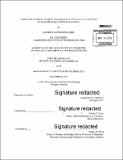| dc.contributor.author | Rowlands, Daniel Walter | en_US |
| dc.contributor.other | Massachusetts Institute of Technology. Department of Chemistry. | en_US |
| dc.date.accessioned | 2016-03-03T21:08:57Z | |
| dc.date.available | 2016-03-03T21:08:57Z | |
| dc.date.copyright | 2015 | en_US |
| dc.date.issued | 2015 | en_US |
| dc.identifier.uri | http://hdl.handle.net/1721.1/101559 | |
| dc.description | Thesis: S.M., Massachusetts Institute of Technology, Department of Chemistry, 2015. | en_US |
| dc.description | Cataloged from PDF version of thesis. Vita. | en_US |
| dc.description | Includes bibliographical references. | en_US |
| dc.description.abstract | While both molecular fluorine (F₂) and xenon difluoride (XeF₂) fluorinate Si(l00)2xI surfaces at coverages up to one monolayer, fluorine is unable to cleave Si-Si bonds that ultimately leads to etching silicon at coverages above one monolayer (reaction probability 9x 10-⁴) while XeF₂ does so readily (reaction probability 0.6). Previous studies have demonstrated that both fluorine and xenon difluoride react with silicon via atom-abstraction mechanisms at low coverages, and that the XeF radicals produced by atom abstraction from xenon difluoride dissociate in the gas phase, producing a source of F radicals that may contribute to Si-Si bond cleavage by formation of multiple F-Si bonds. In addition, it has been shown that van der Waals clusters of F₂ with a Xe atom and with a Kr atom have reaction probabilities with silicon at one monolayer of fluorine coverage of roughly 0.9 and 0.04, respectively, suggesting that the effect of mass of the incident gas molecules is important in activating the cleavage of silicon-silicon bonds through a multiple collision process. A model based on a classical harmonic oscillator linked via a variable damping term to the thermal energy of the lattice is proposed to test the importance of the mass of the gas molecules to energy transfer and the duration of the vibrational excitation of the silicon-silicon lattice bonds. Computer simulations using this model suggest that the mass of the gas molecule does not affect the overall energy transferred to the silicon. However, the heavy mass and the resulting multiple collisions do extend the duration of the silicon excitation and the duration during which the gas molecule is in contact with the vibrationally excited silicon lattice. The techniques that have been used to study the reactivity of fluorine compounds with silicon are potentially of use to the study of another problem: why triplet molecular oxygen (O₂ ) is able to dissociatively chemisorb across singlet silicon-silicon dimer bonds to form the singlet Si-O product. Several mechanisms, including atom abstraction and non-adiabatic ladder climbing of (O₂ )₂ van der Waals dimers are suggested to explain this reaction and a series of experiments to test the hypothesized mechanisms are proposed. In addition, a detailed account of the ultra-high-vacuum molecular beam surface scattering apparatus used for these studies is provided, including a detailed description of its operation and maintenance procedures. | en_US |
| dc.description.statementofresponsibility | by Daniel Walter Rowlands. | en_US |
| dc.format.extent | 284 pages | en_US |
| dc.language.iso | eng | en_US |
| dc.publisher | Massachusetts Institute of Technology | en_US |
| dc.rights | M.I.T. theses are protected by copyright. They may be viewed from this source for any purpose, but reproduction or distribution in any format is prohibited without written permission. See provided URL for inquiries about permission. | en_US |
| dc.rights.uri | http://dspace.mit.edu/handle/1721.1/7582 | en_US |
| dc.subject | Chemistry. | en_US |
| dc.title | Xenon difluoride etching and molecular oxygen oxidation of silicon by reactive scattering | en_US |
| dc.type | Thesis | en_US |
| dc.description.degree | S.M. | en_US |
| dc.contributor.department | Massachusetts Institute of Technology. Department of Chemistry | |
| dc.identifier.oclc | 940567292 | en_US |
